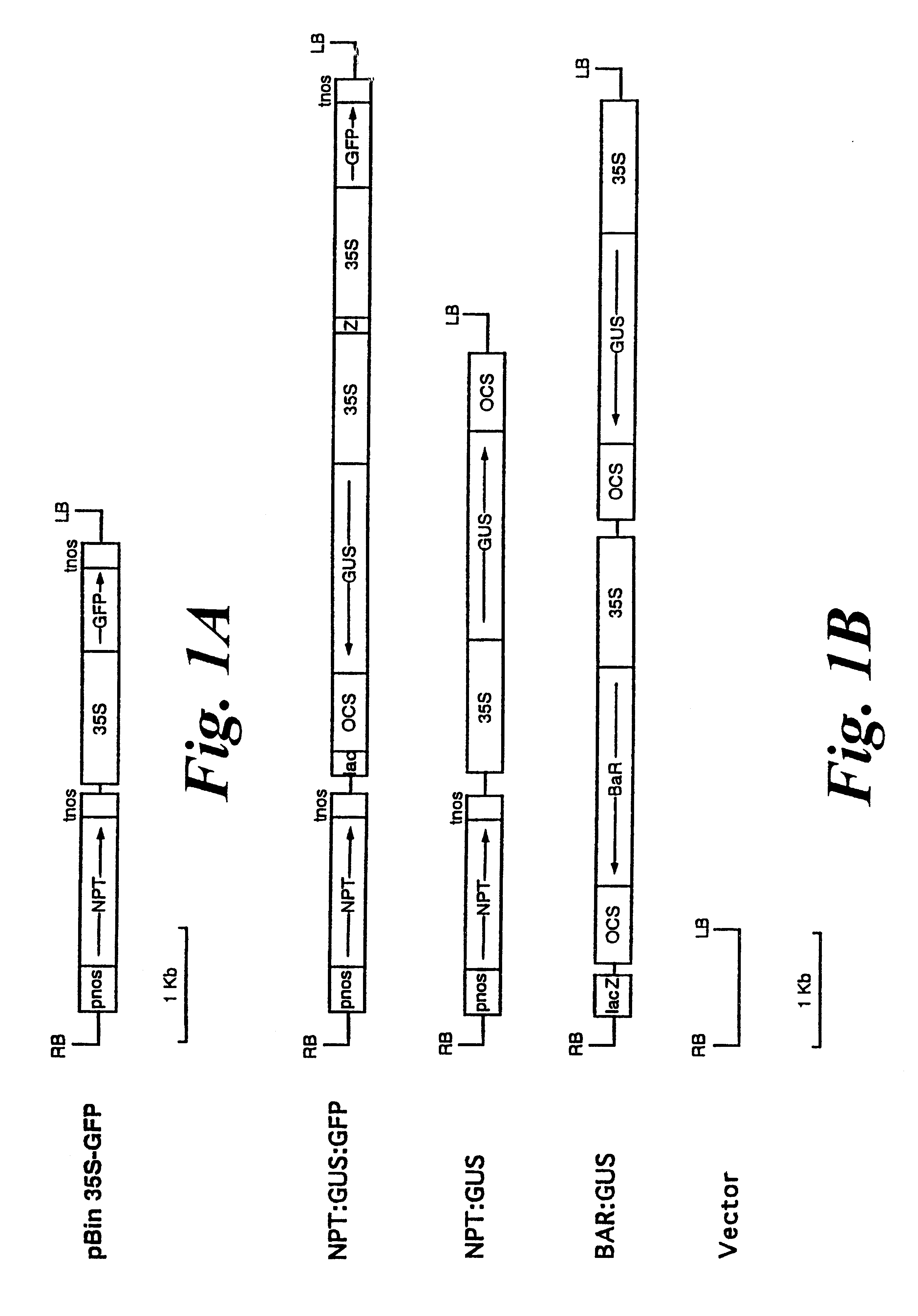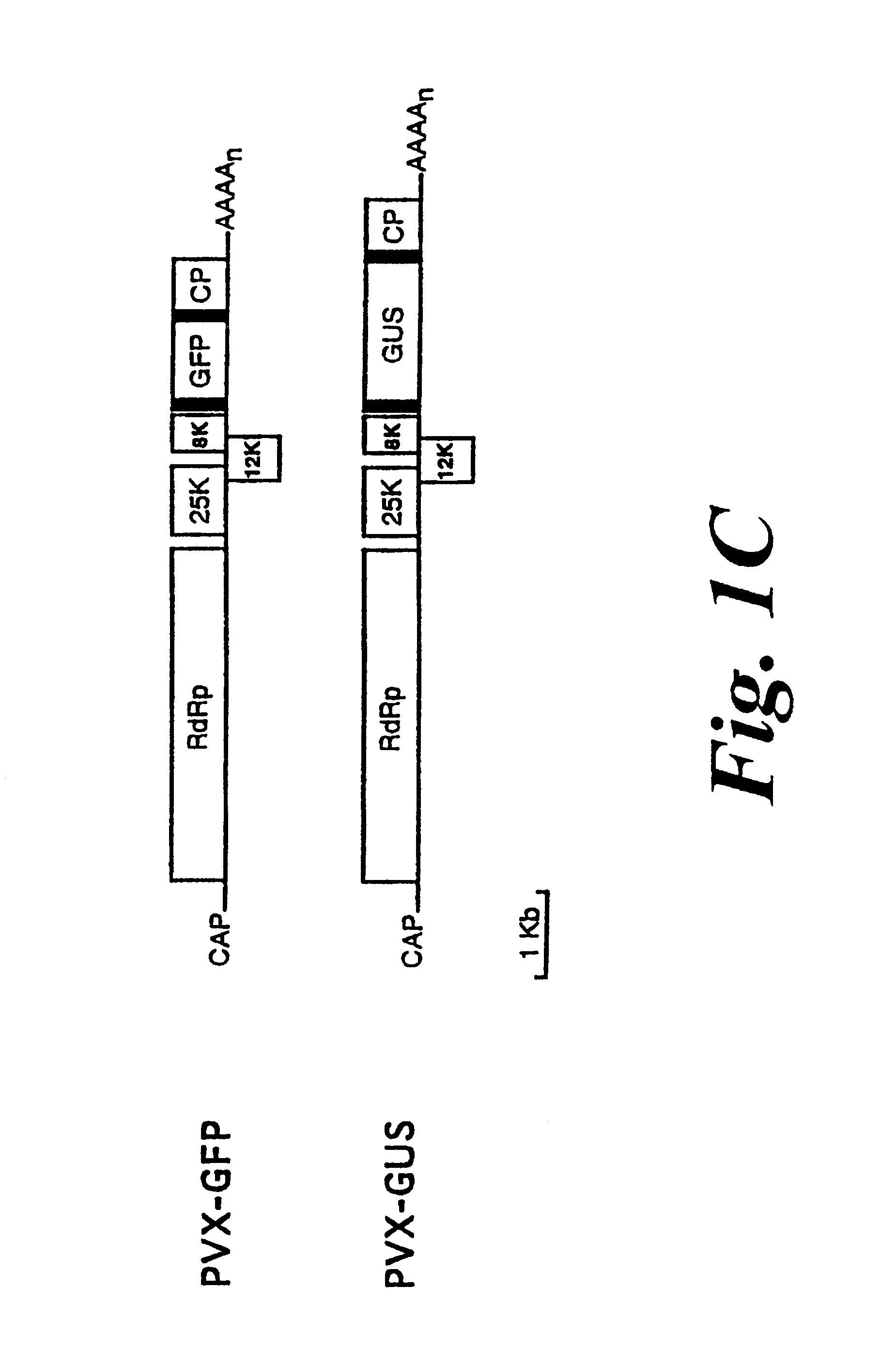Gene silencing methods
a gene and gene technology, applied in the field of gene silencing methods, can solve the problems of low occurrence of gene silencing, difficult to produce many transformants, and unrealistic attempts to attempt gene silencing, so as to reduce the level of gfp mrna fina, reduce the efficiency of gene silencing, and reduce the effect of gene silencing
- Summary
- Abstract
- Description
- Claims
- Application Information
AI Technical Summary
Problems solved by technology
Method used
Image
Examples
examples
General Methods--Examples 1 to 12
Plant Transformation
Four independent lines of Nicotiana benthamiana plants carrying the GFP transgene (stGFP plants) were generated by the A. tumefaciens-mediated leaf disk transformation method.sup.22. For transformation, we used the disarmed Agrobacterium strain GV-3101 containing the binary vector pBin-35S-mGFP5.sup.23. Restriction digestion and Southern analysis showed that each line harbours a single T-DNA integration site, consistent with the observed 3:1 segregation of the expression of GFP in the R1 generation. In all cases, this single locus is associated with one intact copy of the GFP transgene. Northern analysis showed comparable high levels of GFP mRNA in these four independent lines. All stGFP plants used in this work were homozygous, selfed F1 progeny of the primary transformants.
Infiltration of Agrobacterium and the Selective Enrichment Assay
Infiltration of Agrobacterium cultures for transient expression was based on a previously-desc...
examples 13-19
General Methods--Examples 13-19
These were as Above Except
Infiltration of Agrobacterium
Infiltration of A. tumefaciens was based on a previously-described method (English et al., 1997). The constructs shown in FIG. 4 were transferred to A. tumefaciens (strain GV3101, unless otherwise stated) by triparental mating or electroporation and the strains were plated on mina medium. Procedure was as described above.
Grafting Procedure
Non-transformed and transgenic N. benthamiana plants were grown about 1 month before grafting. The stocks were beheaded 10-15 cm from the soil and wedge-grafting was performed with scions of similar age. The graft junction was then fastened and protected from desiccation by Parafilm. During the first week after grafting, plants were covered with a plastic bag to maintain high humidity conditions.
Seedling Bombardment
N. benthamiana seeds were sterilised with 0.25% sodium hypochlorite for 15 min and rinsed 3 times with sterile water. Seeds were germinated for 7-10 da...
example 1
The Gene Silencing Signal Imposes Remote Silencing
To develop a reproducible system for activation of gene silencing we have used transient expression of silencer transgenes in Nicotiana benthamiana. The target of gene silencing (FIG. 1a) in these experiments encodes the jellyfish green fluorescent protein (GFP).sup.11 that can be monitored non-invasively: leaves of transgenic GFP plants appear green under UV light (FIG. 2a) whereas non transgenic (nt) leaves appear red due to chlorophyll fluorescence (FIG. 2b). To deliver silencer transgenes, we infiltrated leaves.sup.12,13 of N. benthamiana with strains of Agrobacterium tumefaciens carrying various binary Ti plasmid vectors (FIG. 1b), including one with a GFP reporter gene. We refer to the stably integrated and transiently expressed GFP transgenes as stGFP and trGFP, respectively.
At 2 days post-infiltration with the NPT:GUS:GFP strain of A. tumefaciens (FIG. 1B) there was expression of both the GUS and the trGFP reporter genes in t...
PUM
| Property | Measurement | Unit |
|---|---|---|
| pH | aaaaa | aaaaa |
| pH | aaaaa | aaaaa |
| area | aaaaa | aaaaa |
Abstract
Description
Claims
Application Information
 Login to View More
Login to View More - R&D
- Intellectual Property
- Life Sciences
- Materials
- Tech Scout
- Unparalleled Data Quality
- Higher Quality Content
- 60% Fewer Hallucinations
Browse by: Latest US Patents, China's latest patents, Technical Efficacy Thesaurus, Application Domain, Technology Topic, Popular Technical Reports.
© 2025 PatSnap. All rights reserved.Legal|Privacy policy|Modern Slavery Act Transparency Statement|Sitemap|About US| Contact US: help@patsnap.com



